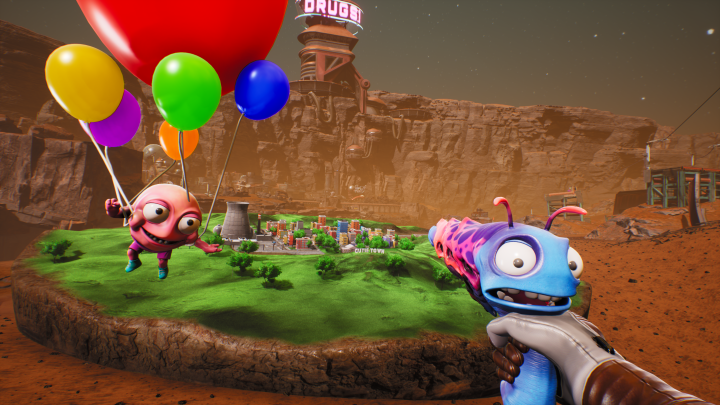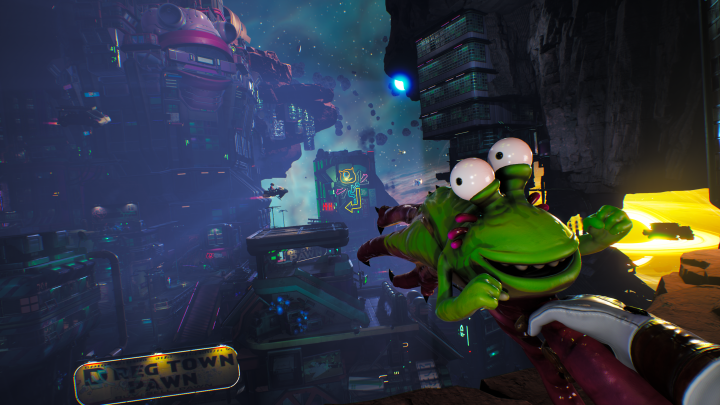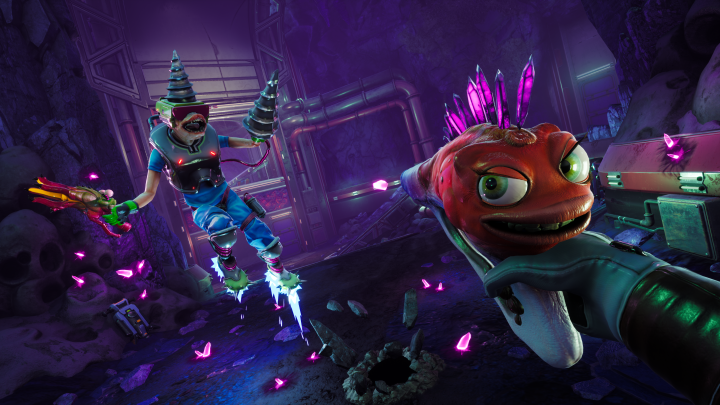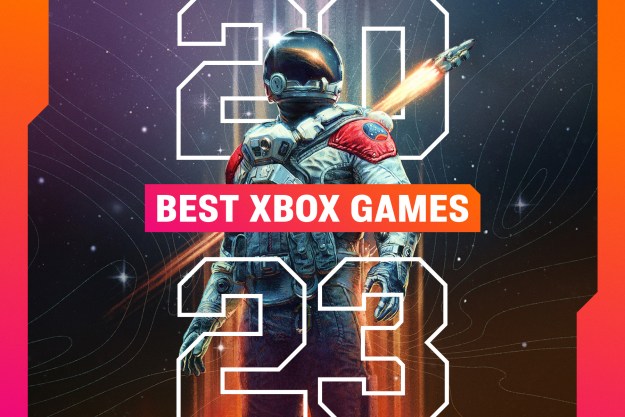As I was sitting down to play the final demo of High on Life, Chief Creative Officer Mikey Spano said the magic word: Metroid.
Nintendo’s classic series was invoked in a simple way, as Spano explained that the upcoming comedy shooter has a gear-gating element to it that lets players unlock more of the world as they gain skills. Just 20 minutes into playing, I couldn’t help but notice that the connection was even stronger thanks to its unique first-person adventure components. I took my headphones off and turned back to Spano, asking if the game was taking design cues from 2002’s Metroid Prime. He lit up, seemingly excited that the DNA was clear.
“It’s like Metroid Prime, but funny!” he said.
That detail made me see High on Life in an entirely new light during my one-hour demo of it. While much of the conversation around the game has been focused on its polarizing comedy, onlookers have yet to understand the full scope of it from a gameplay perspective. That element may make it one of December’s most surprising releases.
Prime time
When I first demoed High on Life at Gamescom, I was mostly focused on its comedy. The shooter had just debuted a joke-filled trailer at Opening Night Live, which landed flat for some, so I wanted to see how that aspect worked in practice (for the record, I found it to be much funnier than that trailer suggested). This time, I wanted to keep my attention on the actual gameplay, so I was a little more tuned out when it came to the jokes. A few stood out — I’m a sucker for a good pants-peeing gag –, but I was more surprised by the game’s structure.
We kind of fell into doing more of a structure like Metroid Prime 2: Echoes …
The first demo had me convinced High on Life was a fairly linear game, but that’s not the case. Every act gives players the choice to accept one of two bounties, which will take them on a different quest. They’ll only be able to play through one, which means that their second playthrough could be an entirely different game. In my snippet, I was shipped off to a desert planet and tasked with hunting down a hard-ass military drill sergeant named Douglas.
I quickly found that the world had much more optional, explorable space than I saw in my first demo. At one point, I sauntered into a saloon filled with random NPCs that I could talk to, including a flute-playing alien with a very wiggly butt. Spano noted that I was the first player in two days of demos to walk into the saloon at all. At another point, I found a “warp” point that opened up a side scene where a miniature city appeared before me and a tiny NPC invited me to explore it. Naturally, I completely destroyed it like a kaiju as I walked through it. It was an entirely optional moment that didn’t yield any specific rewards other than some hearty laughs.

The planet I explored was compact, but filled with little secrets like that. That made it feel much bigger than it was, which is specifically where the game’s Metroid influence shows itself in a less obvious way.
“Metroid Prime is the overall theme we were going for,” Spano tells Digital Trends. “We had the limitation of a smaller team, so we thought we couldn’t do this huge interconnected world. So we kind of fell into doing more of a structure like Metroid Prime 2: Echoes where you have a hub — which in that one is your ship and in our game is the house. So from there, you can go to different planets that are all connected through the house, but they’re not connected to each other.”
The Metroid Prime influence is immediately clear in its gameplay too. This slice was much more traversal heavy, as I used my pal Knifey to grapple over gaps and solve platforming puzzles using my globshot (a charged shot that can knock down metal platforms, sometimes requiring you to bounce it off of adjacent walls to get the angle right). Its most-involved puzzle had me connecting a pipe pathway by shooting the correct junctions into place. Calling it a shooter is a bit misleading; it’s a first-person adventure game.
Shine and combine
What really stood out this time around was the depth of its systems. While I only had one gun and my knife in the first demo, which felt a little basic at the time, the new talking weapon I had here broke combat wide open. Gus, voiced by J. B. Smoove, acts like a green shotgun with its powerful primary blast. That’s only one of his functions, though. By pressing the left trigger, I can vacuum enemies toward me, allowing me to pull them in close enough to obliterate them.
It’s his other special ability, though, that sells me on what High on Life is doing with its combat. By pressing the right bumper, I throw out a sort of metal boomerang that smacks enemies before returning in my direction. If I time it just right, I can melee it when it’s close to me and send it back out. It doesn’t perfectly return to me, so I have to get myself into the right position to thwack it like a volleyball player moving on the court. It’s an incredibly satisfying move when you pull it off, especially when combining it with other Gus’ other functions.

That idea is the real heart of High on Life’s combat, and even its general traversal too. Part of that vision was inspired by Doom Eternal (you’ll see some familiar execution animations here that almost parody that game’s gruesome kills), but Spano says that the team at Squanch was moving toward that idea even before that game launched.
“One of our initial pillars was ‘shine and combine,’” Spano says. “The idea was: to play the game well, you need to combine all these moves together. And that went through a lot of different iterations, and what we settled on was a sort of opt-in system. If you can figure out the combos, that’s awesome, but you don’t have to use them to play through. I hope people figure out stuff we didn’t even think of.”
I get a real feel for that idea at the end of the demo when I finally go face-to-face with Douglas in a traditional boss fight. I have to shoot at him while he leaps around a square room, all while avoiding an electrified floor. Using all the skills I’d honed, I’m bouncing my boomerang at him three times to put a dent in his health bar, stunning him with the globshot, and following up with a stab for good measure. It’s a tough fight (Spano jokes that High on Life is “Elden Ring, but hard”), but I’m able to weather it by taking full advantage of that “shine and combine” philosophy. Spano told me that I was the first person during the demo days to beat it in one try, leaving him to joke — or maybe not — that Squanch should make it even harder.

At the tail end of the demo, I get a third gun that really gets me excited to take that idea further. Sweezy is a design parody of Halo’s Needler – when Spano says they thought it would be funny to spoof Halo’s worst gun, I’m quick to defend its honor — that can shoot a time -slowing bubble at enemies. Theoretically, here’s something you could do in combat: launch an enemy into the air with a globshot, freeze them in midair, knock them a few times with Gus’ boomerang, vacuum them toward you, and finish them off with a shotgun blast. And that’s without even having all of the game’s guns.
While the humor seems like it’ll be a polarizing point for players, what Squanch is doing with its core gameplay philosophy should be a bit more universally appealing. The slice I played showed off a well-built first-person adventure game with strong gunplay that can go as deep or casual as you want. Its Metroid Prime, Doom Eternal, and Sunset Overdrive (two key team members worked on the latter) influences all mesh together in ways that might surprise the skeptics. If that sounds like your speed, but you haven’t been sold on its jokes so far, remember that the volume button is your friend.
High on Life launches on December 13 for Xbox One, Xbox Series X/S, and PC. It’ll be available via Xbox Game Pass.
Editors' Recommendations
- 3 Xbox Game Pass games you need to play this weekend (May 3-5)
- Fallout 4 is finally getting free Xbox Series X and PS5 upgrades
- Another Crab’s Treasure is an approachable Soulslike with a comedic twist
- Xbox games on PS5? It’s not as shocking as you think
- You need to try this new, adrenaline-fueled Xbox Game Pass highlight



